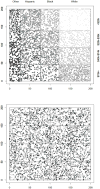Brains in the city: Neurobiological effects of urbanization
- PMID: 25936504
- PMCID: PMC4774049
- DOI: 10.1016/j.neubiorev.2015.04.007
Brains in the city: Neurobiological effects of urbanization
Abstract
With a majority of humans now living in cities, strategic research is necessary to elucidate the impact of this evolutionarily unfamiliar habitat on neural functions and well-being. In this review, both rodent and human models are considered in the evaluation of the changing physical and social landscapes associated with urban dwellings. Animal models assessing increased exposure to artificial physical elements characteristic of urban settings, as well as exposure to unnatural sources of light for extended durations, are reviewed. In both cases, increased biomarkers of mental illnesses such as major depression have been observed. Additionally, applied human research emphasizing the emotional impact of environmental threats associated with urban habitats is considered. Subjects evaluated in an inner-city hospital reveal the impact of combined specific genetic vulnerabilities and heightened stress responses in the expression of posttraumatic stress disorder. Finally, algorithm-based models of cities have been developed utilizing population-level analyses to identify risk factors for psychiatric illness. Although complex, the use of multiple research approaches, as described herein, results in an enhanced understanding of urbanization and its far-reaching effects--confirming the importance of continued research directed toward the identification of putative risk factors associated with psychiatric illness in urban settings.
Keywords: Agent-based models; Animal models; Collective efficacy; Depression; Intercity violence; Light pollution; Natural environment; PTSD; Psychiatric illness; Self-efficacy; Socioeconomic disadvantage; Urbanization.
Copyright © 2015 Elsevier Ltd. All rights reserved.
Figures




References
-
- American Psychiatric Association, A.P. Diagnostic and Statistical Manual of Mental Disorders. 4th, text review. Washington DC: Author; 2000.
-
- American Psychiatric Association. Diagnostic and Statistical Manual of Mental Disorders. 5th. Washington DC: Author; 2013.
Publication types
MeSH terms
Grants and funding
- R56 MH071537/MH/NIMH NIH HHS/United States
- R01 MH100122/MH/NIMH NIH HHS/United States
- MH092576/MH/NIMH NIH HHS/United States
- MH071537/MH/NIMH NIH HHS/United States
- MH096764/MH/NIMH NIH HHS/United States
- R21 DA041154/DA/NIDA NIH HHS/United States
- R21 MH092576/MH/NIMH NIH HHS/United States
- R21 MH098212/MH/NIMH NIH HHS/United States
- R01 MH071537/MH/NIMH NIH HHS/United States
- MH100122/MH/NIMH NIH HHS/United States
- R21 AA021909/AA/NIAAA NIH HHS/United States
- HHMI/Howard Hughes Medical Institute/United States
- K01 DA030449/DA/NIDA NIH HHS/United States
- R01 MH096764/MH/NIMH NIH HHS/United States
- MH098212/MH/NIMH NIH HHS/United States
LinkOut - more resources
Full Text Sources
Other Literature Sources

